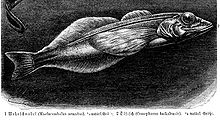- Golomyanka
-
Golomyankas 
Scientific classification Kingdom: Animalia Phylum: Chordata Class: Actinopterygii Order: Scorpaeniformes Family: Comephoridae Genus: Comephorus
Lacepède, 1800Species - C. baikalensis
- C. dybowskii
The golomyankas (lit. "fat fish") or Baikal oilfish are two species of peculiar sculpin-like fishes endemic to Lake Baikal in Russia.
Contents
Description
Golomyankas have a translucent body with no scales. They have long pectoral fins, and although pelvic bones are present, they lack pelvic fins. Golomyankas have a strong lateral line. The lateral line system on the head consists of large cavities linked by narrow bony bridges with small external pores. Lack of a swim bladder, high lipid content and porous bones allow the fish to tolerate varying pressure extremes as it moves through the water column. Over a third of the body weight (38.9%) of C. baicalensis is oil.
Biology and ecology
They are the principal ecological competitor to the omul, and represent a primary food source for the nerpa seal. They are easily identifiable, and are large enough (at 15-20 centimeters) to be easily seen. Golomyanka are unusual for their habit of moving throughout the entire water column of Lake Baikal without much regard for changes in pressure, although they can exist only within a very narrow range of temperatures and generally tend to find their ecological niche at 700–1600 feet. They are considered the world's most abyssal freshwater fish. They are also known for rapidly decomposing in sunlight, leaving behind fat, oil, and bones.
The biomass of the golomyanka population is estimated at anywhere from 100 to 150 thousand tons, making it one of the most populous forms of vertebrate life in Lake Baikal. They are extensively preyed upon by nerpa, for which the golomyanka are the primary food source. Food sources for the golomyanka are fairly varied, including their own young and pelagic crayfish. Shoaling behavior is not known for this species, and the females do not lay eggs; rather, they are viviparous, producing a swarm of 2000-3000 larvae when they reach sexual maturity at two to three years.
Relationship to humans
Due to their solitary lives, golomyanka are not harvested commercially, although their fats and oils are used medicinally when storms toss them up on shore. They are valued primarily as the principal food source for the nerpa, which are harvested commercially. They are so numerous and spawn so rapidly that they represent the largest concentration of fish biomass within the entire lake, and represent a grave threat to the ecosystem of Lake Baikal if not constantly fed upon by predators.
See also
References
Ichthyofauna of Lake Baikal from Baikal Web World, accessed May 5, 2006 (with a photo of the golomyanka).
Lake Baikal FAQ Irkutsk State University Lake Baikal FAQ, accessed May 5, 2006
Animals and plants of Lake Baikal from Irkutsk State University, accessed May 5, 2006
Lipids and fatty acids of two pelagic cottoid fishes (Comephorus spp.) endemic to Lake Baikal, T.A. Kozlovaa and S.V. Khotimchenko, accessed July 31, 2010Categories:- Scorpaeniformes
- Viviparous fish
- Russian loanwords
Wikimedia Foundation. 2010.
